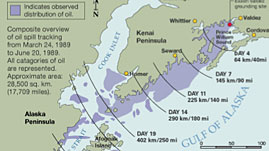Teachers' Domain - Digital Media for the Classroom and Professional Development
User: Preview

Source: Prince William Sound Regional Citizens' Advisory Council, KTOO, and NOVA: "The Big Spill"
This interactive activity featuring videos adapted from the Prince William Sound Regional Citizens' Advisory Council, KTOO, and NOVA: "The Big Spill" explains how oil and other environmental contaminants jeopardize the health of animal and human populations along the Alaska coastline. It also features four strategies that the region's residents have developed since the 1989 Exxon Valdez oil spill in Prince William Sound to safeguard against incidents that may disrupt the local ecosystem: using tugboats to help steer tanker vessels, requiring the use of double-hulled tankers in Alaskan ports, developing near-shore clean-up response tactics in the event of future spills, and contaminant impact studies.
Contrary to a common perception, the Arctic is not a pristine wilderness. Traces of contaminants can be found in its air, soil, water, and living things. Some contaminants arrive via atmospheric and oceanic circulation. Others are released locally. The most significant contaminants that originate in the Arctic are related to oil-industry emissions, spills, and fires. Their impact reaches well beyond an immediate release point, spreading throughout the ecosystem. Understanding the sources of oil contamination and its various effects has helped people design mitigation strategies.
While large tanker accidents may be the most commonly cited oil hazard, the risk is not limited to spills at sea. Once in port, tankers release toxic vapors when their cargo holds are opened. These volatile organic compounds can produce serious health effects in humans, plants, and animals. Tankers also release ballast water into port waters. Ballast water is seawater taken on board at a voyage's port of origin and used to help stabilize a ship at sea. It may contain non-indigenous aquatic organisms, including bacteria, plankton, mussels, and fish, which can disrupt the ecosystem into which they are introduced and endanger the native plants or animals.
Pipelines that transport oil over land can corrode and rupture, leaking thousands of gallons of oil into soil and streams. Drilling and extraction activities—both on-shore and off—pollute the air and alter habitat through the construction of roads, airstrips, well pads, and gravel pits. According to federal studies, more than 350 spills, explosions, and fires in the past 40 years have released more than 270,000 gallons of oil and other contaminants into Alaska's Kenai National Wildlife Refuge alone, which contains nearly 200 operating wells.
Oil-related contaminants persist for longer periods in the Arctic because low temperatures and light conditions produce lower evaporation and decomposition rates. In the marine environment, oil gets pushed further to sea by the ice pack and gets entrapped in the ice. In the tundra environment, leaked oil may remain for several years. Oil fires produce smoke clouds that are concentrated at very low altitudes. These clouds reduce solar radiation and contain particulates and other pollutants harmful to human health and to the productivity of marine and terrestrial environments.
Because environmental contaminants impact Arctic ecosystems, people who rely on it for food are also at risk. Subsistence communities that rely on the hunting of whales, polar bears, walruses, and seals are finding their fatty, high-energy food sources to be laden with industrial chemicals. Toxins are accumulating in animal tissue through biological magnification. The populations of other traditional food sources, such as caribou, are threatened because lichens, their main food source, are especially vulnerable to contamination by air pollution.
 Loading Standards
Loading Standards Teachers' Domain is proud to be a Pathways portal to the National Science Digital Library.
Teachers' Domain is proud to be a Pathways portal to the National Science Digital Library.
